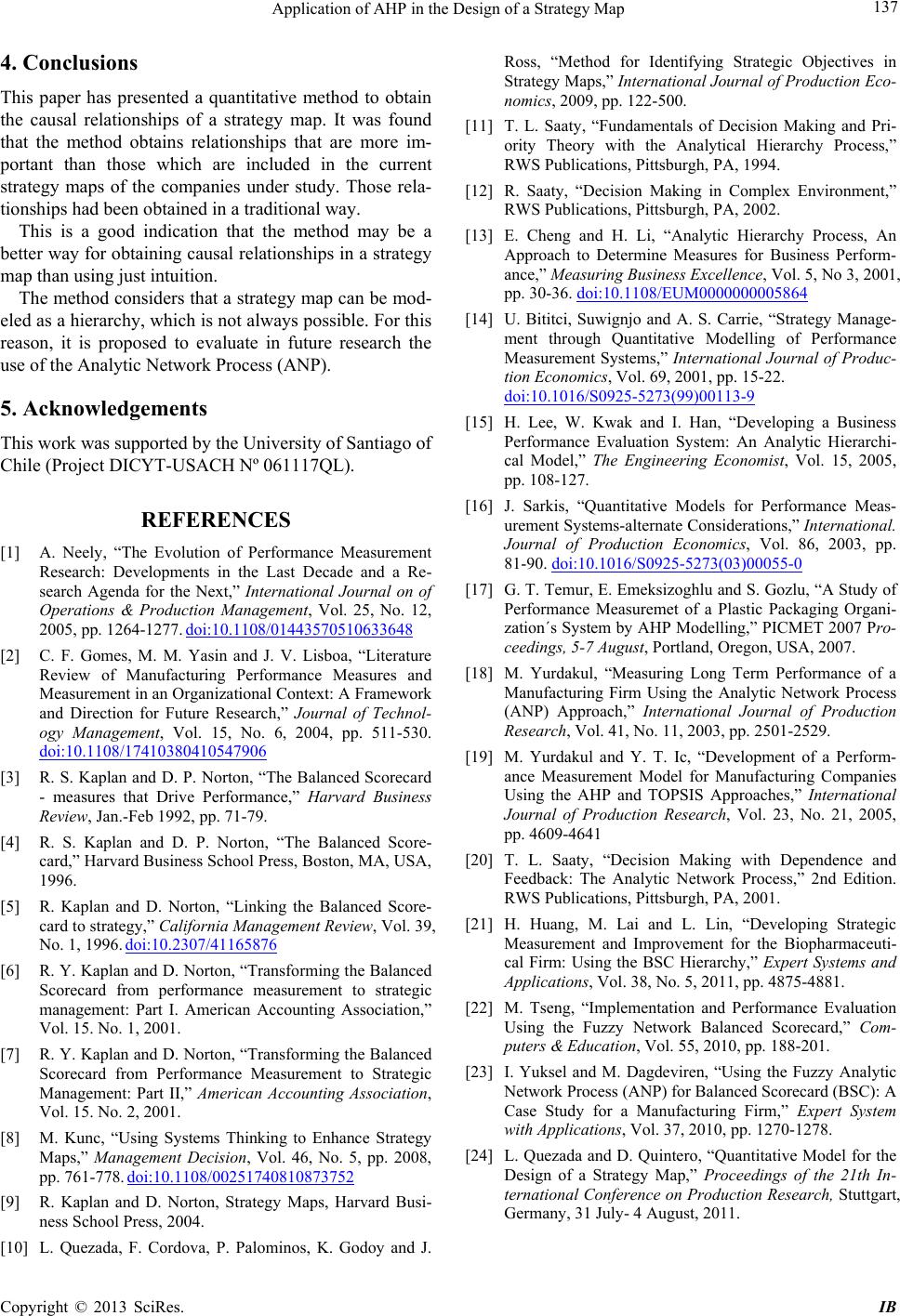
Application of AHP in the Design of a Strategy Map 137
4. Conclusions
This paper has presented a quantitative method to obtain
the causal relationships of a strategy map. It was found
that the method obtains relationships that are more im-
portant than those which are included in the current
strategy maps of the companies under study. Those rela-
tionships ha d been obtained in a tradi ti onal w a y .
This is a good indication that the method may be a
better way for obtaining causal relationships in a strategy
map than using just intuition.
The method considers that a strategy map can be mod-
eled as a hierarchy, which is not always possible. For this
reason, it is proposed to evaluate in future research the
use of the Analytic Network Process (ANP).
5. Acknowledgements
This work was supported by the University of Santiago of
Chile (Project DICYT-US ACH Nº 061117Q L).
REFERENCES
[1] A. Neely, “The Evolution of Performance Measurement
Research: Developments in the Last Decade and a Re-
search Agenda for the Next,” International Journal on of
Operations & Production Management, Vol. 25, No. 12,
2005, pp. 1264-1277. doi:10.1108/01443570510633648
[2] C. F. Gomes, M. M. Yasin and J. V. Lisboa, “Literature
Review of Manufacturing Performance Measures and
Measurement in an Organizational Context: A Framework
and Direction for Future Research,” Journal of Technol-
ogy Management, Vol. 15, No. 6, 2004, pp. 511-530.
doi:10.1108/17410380410547906
[3] R. S. Kaplan and D. P. Norton, “The Balanced Scorecard
- measures that Drive Performance,” Harvard Business
Review, Jan.-Feb 1992, pp. 71-79.
[4] R. S. Kaplan and D. P. Norton, “The Balanced Score-
card,” Harvard Business School Press, Boston, MA, USA,
1996.
[5] R. Kaplan and D. Norton, “Linking the Balanced Score-
card to strategy,” California Management Review, Vol. 39,
No. 1, 1996. doi:10.2307/41165876
[6] R. Y. Kaplan and D. Norton, “Transforming the Balanced
Scorecard from performance measurement to strategic
management: Part I. American Accounting Association,”
Vol. 15. No. 1, 2001.
[7] R. Y. Kaplan and D. Norton, “Transforming the Balanced
Scorecard from Performance Measurement to Strategic
Management: Part II,” American Accounting Association,
Vol. 15. No. 2, 2001.
[8] M. Kunc, “Using Systems Thinking to Enhance Strategy
Maps,” Management Decision, Vol. 46, No. 5, pp. 2008,
pp. 761-778. doi:10.1108/00251740810873752
[9] R. Kaplan and D. Norton, Strategy Maps, Harvard Busi-
ness School Press, 2004.
[10] L. Quezada, F. Cordova, P. Palominos, K. Godoy and J.
Ross, “Method for Identifying Strategic Objectives in
Strategy Maps,” International Journal of Production Eco-
nomics, 2009, pp. 122-500.
[11] T. L. Saaty, “Fundamentals of Decision Making and Pri-
ority Theory with the Analytical Hierarchy Process,”
RWS Publications, Pittsburgh, PA, 1994.
[12] R. Saaty, “Decision Making in Complex Environment,”
RWS Publications, Pittsburgh, PA, 2002.
[13] E. Cheng and H. Li, “Analytic Hierarchy Process, An
Approach to Determine Measures for Business Perform-
ance,” Measuring Business Excellence, Vol. 5, No 3, 2001,
pp. 30-36. doi:10.1108/EUM0000000005864
[14] U. Bititci, Suwignjo and A. S. Carrie, “Strategy Manage-
ment through Quantitative Modelling of Performance
Measurement Systems,” International Journal of Produc-
tion Economics, Vol. 69, 2001, pp. 15-22.
doi:10.1016/S0925-5273(99)00113-9
[15] H. Lee, W. Kwak and I. Han, “Developing a Business
Performance Evaluation System: An Analytic Hierarchi-
cal Model,” The Engineering Economist, Vol. 15, 2005,
pp. 108-127.
[16] J. Sarkis, “Quantitative Models for Performance Meas-
urement Systems-alternate Considerations,” International.
Journal of Production Economics, Vol. 86, 2003, pp.
81-90. doi:10.1016/S0925-5273(03)00055-0
[17] G. T. Temur, E. Emeksizoghlu and S. Gozlu, “A Study of
Performance Measuremet of a Plastic Packaging Organi-
zation´s System by AHP Modelling,” PICMET 2007 Pro-
ceedings, 5-7 August, Portland, Oregon, USA, 2007.
[18] M. Yurdakul, “Measuring Long Term Performance of a
Manufacturing Firm Using the Analytic Network Process
(ANP) Approach,” International Journal of Production
Research, Vol. 41, No. 11, 2003, pp. 2501-2529.
[19] M. Yurdakul and Y. T. Ic, “Development of a Perform-
ance Measurement Model for Manufacturing Companies
Using the AHP and TOPSIS Approaches,” International
Journal of Production Research, Vol. 23, No. 21, 2005,
pp. 4609-4641
[20] T. L. Saaty, “Decision Making with Dependence and
Feedback: The Analytic Network Process,” 2nd Edition.
RWS Publications, Pittsburgh, PA, 2001.
[21] H. Huang, M. Lai and L. Lin, “Developing Strategic
Measurement and Improvement for the Biopharmaceuti-
cal Firm: Using the BSC Hierarchy,” Expert Systems and
Applications, Vol. 38, No. 5, 2011, pp. 4875-4881.
[22] M. Tseng, “Implementation and Performance Evaluation
Using the Fuzzy Network Balanced Scorecard,” Com-
puters & Education, Vol. 55, 2010, pp. 188-201.
[23] I. Yuksel and M. Dagdeviren, “Using the Fuzzy Analytic
Network Process (ANP) for Balanced Scorecard (BSC): A
Case Study for a Manufacturing Firm,” Expert System
with Applications, Vol. 37, 2010, pp. 1270-1278.
[24] L. Quezada and D. Quintero, “Quantitative Model for the
Design of a Strategy Map,” Proceedings of the 21th In-
ternational Conference on Production Research, Stuttgart,
Germany, 31 July- 4 August, 2011.
Copyright © 2013 SciRes. IB